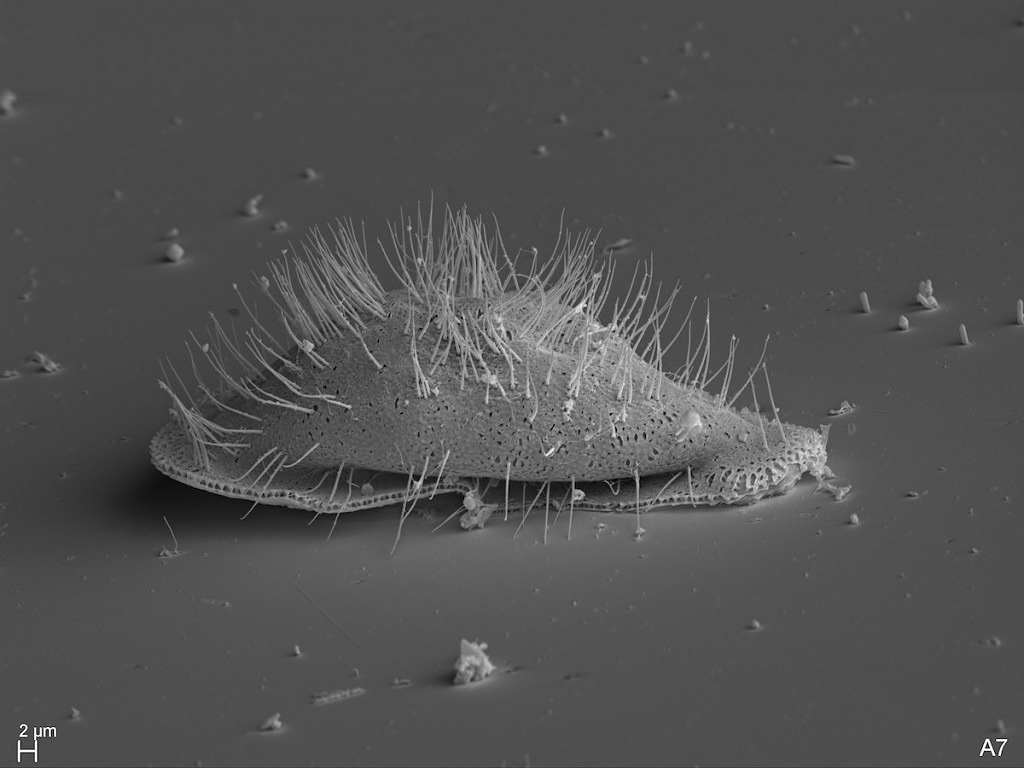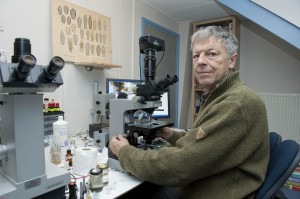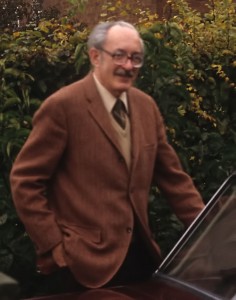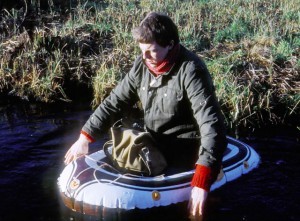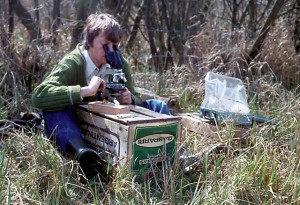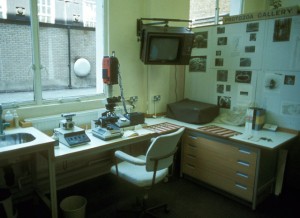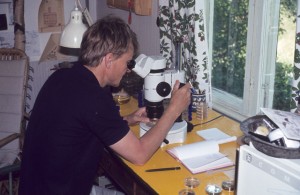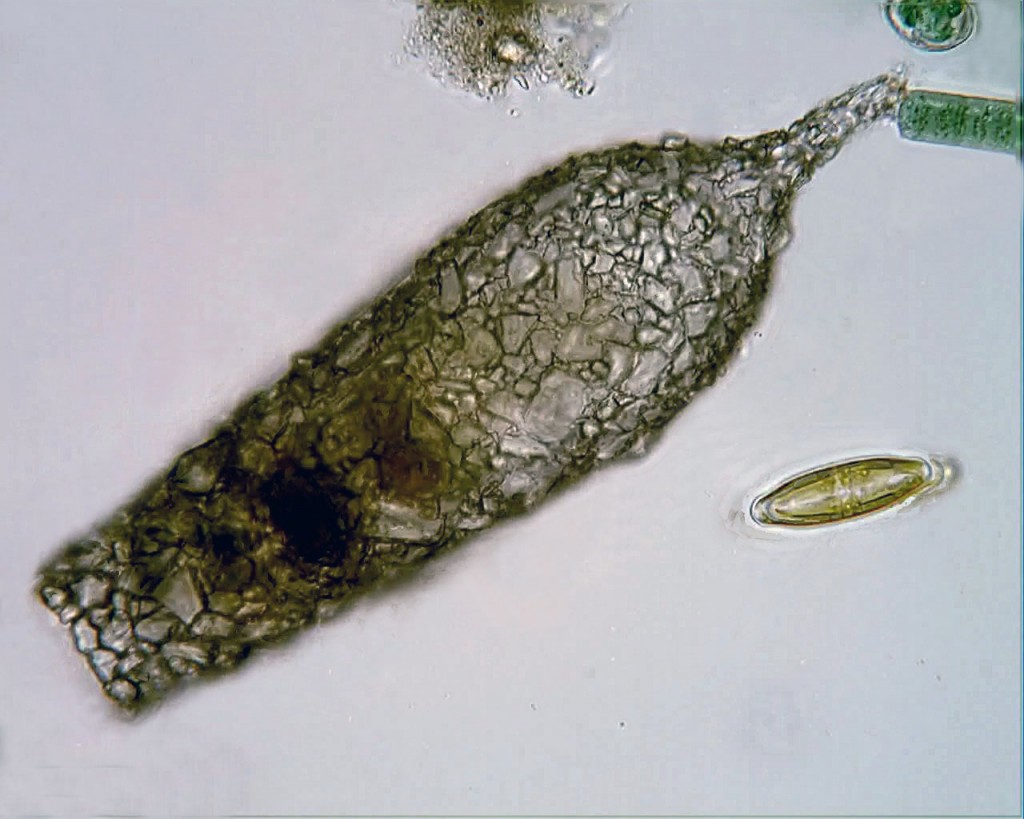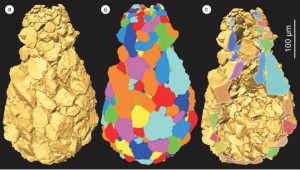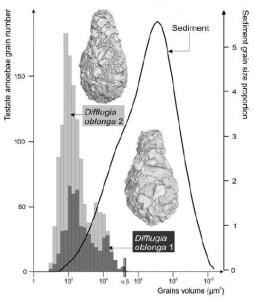It’s been less than half a year since Eckhard Voelcker and Steffen Clauß launched their enchanting online gallery of amoeboid organisms, www.Penard.de. Already, it has emerged as one of the best places to find micrographs of amoebae and heliozoans, and the collection is continuing to grow and improve. The site features some superb light microscopy, but also sumptuously clear and detailed scanning electron micrographs prepared in Eckhard’s own basement laboratory.
Eckhard is an unusual guy. A self-taught programmer, he spent several decades in software development (at the head of Völcker Informatik AG) before turning, in midlife, to the exploration of amoeboid protists. He has pursued the new discipline in a remarkably organized and self-assured way, and, in collaboration with Steffen Clauß, has begun to make real contributions to the field. As an amateur scientist working at a high level, Eckhard seemed like a perfect subject for ”Meet the Protistologist”. I contacted him a few weeks ago, and he agreed to answer some questions.
“The child is father of the man,” as the poet Wordsworth said. I would like to know something about your earlier life. Where did you grow up? Were you exposed to the natural sciences as a child?
I grew up in northern Germany. Natural sciences were always my favorite subjects and I wanted to study chemistry or biology. Somehow I ended up becoming a computer scientist and moved to Berlin. Here I started my own software firm a couple of years later. Biology became a hobby of mine and I enjoyed watching microbes with the microscope to relax after work. It was in the year 2010, after a large corporation bought my firm, that I started to think about my future. So I started to plan for an early retirement and went as often as possible to the university, where a friend of mine, Klaus Hausmann, was a professor teaching and researching protistology. After Klaus introduced me to the electron microscope, I was hooked. I planned and built a protistology laboratory with an electron microscope in my basement and decided to focus on this and not software anymore.
So, you had no formal training in protistology or microscopy, before you began to visit Klaus Hausmann’s lab at the Freie Universität Berlin? Did you do any work at his facility, or were you simply observing?
I had been a member of the Berlin Microscopic Society for some years and my microscopic interest was mainly protists. So I did spend many hours observing, reading papers and studying books. When I would find an amoeba unknown to me, I would try to identify at least the genus and then read the available literature about it. That was why I started with the EM in the first place. I found Cochliopodium amoebae and was interested in the scale structure that is invisible with the light microscope. Somehow I convinced Klaus Hausmann that this would be interesting and he promised to help me learning the EM preparation and operation. There was this magical day a couple of weeks later that I remember so well. I had brought a culture of Cochliopodium vestitum to the university and we put some cover slips in petri dishes and filled these with my culture. A couple of days later it was my birthday and I had decided to take the day off and prepare for the EM. In the afternoon, when the preparation was done, I went to Klaus’s office proudly holding 6 sputter-coated coverslips on EM stubs and together we went down to the SEM. It was a magic moment when I first saw those delicate scales – and it was my first very own preparation (Klaus said I was very lucky to be successful right away – oh boy, was he right). When I had dinner with my wife that evening, I told her, this is what I want to do when I am done with my job. It took me some years though to finalize my work and to build my lab, but now it is all done. Klaus Hausmann has retired two years ago and the lab at the university is not a hotspot for protistology anymore as his successor is focusing on evolution.
You’ve mentioned to me that you learn best on your own, outside an academic context. Could you elaborate on that?
It has nothing to do with the academic context. When I listen to a lecture on video, I will pause that lecture a dozen times or so and check something, often to dig deeper into a certain detail. After my curiosity is satisfied, I will continue the lecture. I cannot do this when somebody stands in front of a blackboard “live”.
How did you begin planning your home lab? You must have been acquiring new knowledge and skills at a prodigious rate.
Planning my lab was fairly easy. I knew what I needed for preparation and there was only one room available anyway. So basically it was just the question, how do you fit a fume hood, refrigerator and deep freezer for chemicals, a SEM, sputter coater and critical point dryer into one room. Originally I planned to leave the light microscopy at my old lab in my study, but this proved to be not practical. So I moved everything down into the lab, although it is a bit cramped now. But as my wife said, this removed the danger of me buying yet another microscope.
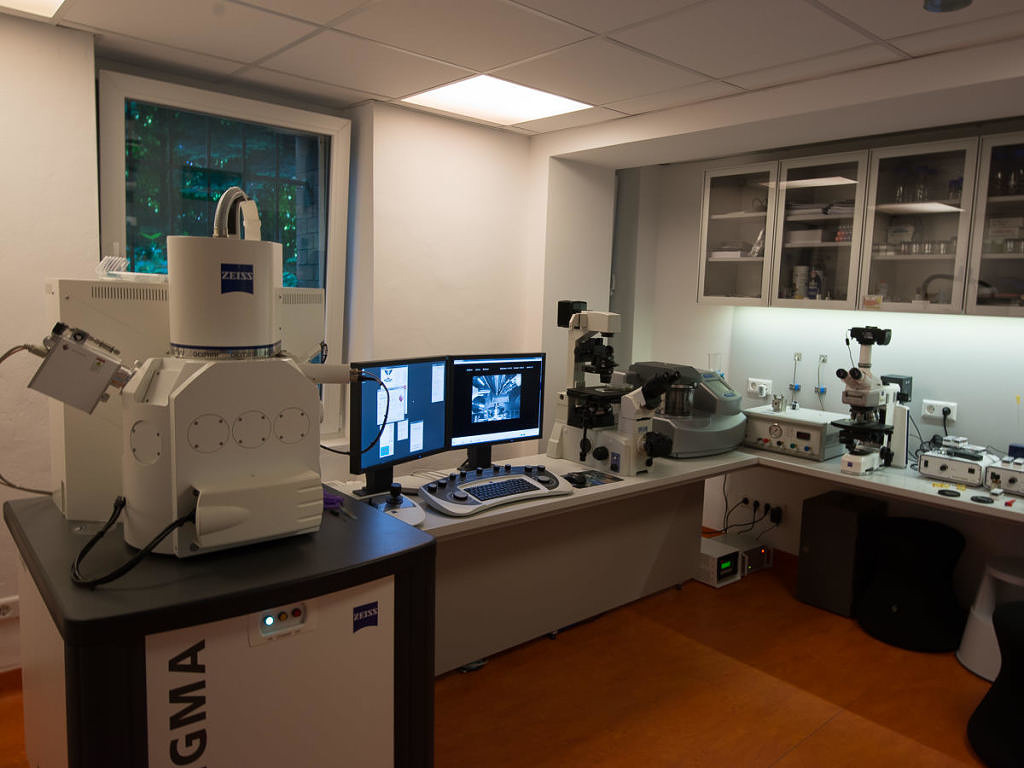
Eckhard’s home laboratory, with Zeiss Sigma Scanning Electron Microscope at the left. (Source: Eckhard Voelcker)
Did you have collaborators in the beginning? Were you already working with Steffen Clauß?
I got in contact with Ferry Siemensma pretty early. He helped me to identify some amoeba and we have spent many hours on the phone. It was Ferry who brought Steffen and me together. Steffen had found an undescribed testate amoeba and wanted to know how to prepare it for the EM. Eventually we met and got to know each other. We were in the same position, hobbyists working alone with an exotic (to say the least) passion for amoebae. In the spring of this year we came up with the idea to create a website about amoebae combining light- and electron-microscopic images.
So, even at the start you had a particular interest in amoebae. What attracts you to them?
When I had my first small microscope it did not take long to stumble across Arcella discoides. It looked so strange, so perfectly round, simply incredible, like a flying saucer. I realized that there was more to amoebae besides being a blob of slime. The more I looked into amoebae and heliozoans the more fascinated I became.
Have you singled out certain taxa or biological phenomena for closer study?
I have a special interest in cells with scales. Some of the “naked” amoebae are really not naked, but covered with minute scales of a specific structure. Korotnevella and Cochliopodium are two nice examples. Also some heliozoans, especially Pterocystis fascinate me. When we sample in unspoiled environments, we will find species that have been more or less forgotten since over 100 years and that have never been imaged with an electron microscope. We also find many undescribed species. When I load a preparation into the electron microscope and I see an undescribed species, it really is some kind of golden moment. I am the first human who is seeing this species. But the challenge is to isolate and culture so molecular data can be obtained. Without molecular data you cannot describe new species these days. And publishing what we find is an important goal. I hope that next year we will be able to do this.
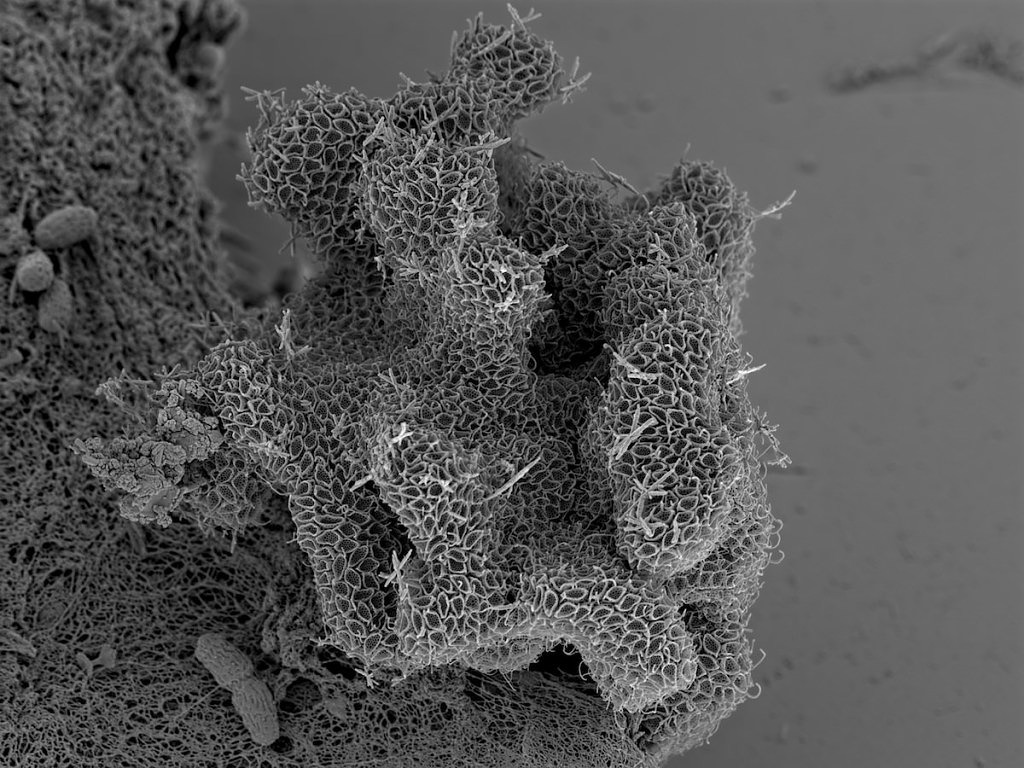
Korotnevella sp. looks like a “naked” amoeba in transmitted light, but SEM reveals its cloak of intricate scales. Source: Eckhard Voelcker.
Many of your micrographs are as aesthetically pleasing as they are informative. Do you have any thoughts about the role of art in science, or science in art?
This is a very interesting question. Most boys of my generation, as some generations before me, received at some point in their youth a microscope as a present. Looking into pond water to see the wonders of paramecium, euglena etc. was very common. Today internet gaming, social media etc. seems to be more popular and „young scientists“, who explore their surrounding nature with the microscope or a looking glass have become very rare. If we want to make people understand, that environmental protection is not only about rare plants and animals, but about unspoiled environments, swamps etc, we need to show them there is something wonderful living in these waters. If we want to make people excited about science, we need to make it visually attractive. I fully understand why most scientists don’t bother about aesthetics in their images. They have little time, are under pressure to produce papers etc. But this will create little public enthusiasm about their work. And this leads to less funding. For Steffen and me, if we can’t show an amoeba in a nice image, we won’t show it at all.
In many natural sciences, even in mathematics, very often the most fundamental equations are very aesthetic. Look at the mandelbrot set. Or look at some important equations like e = mc2, c2 = a2 + b2, or my favorite one, Euler’s eiπ + 1 = 0 that combines 5 of the most important numbers. And the result is a circle!
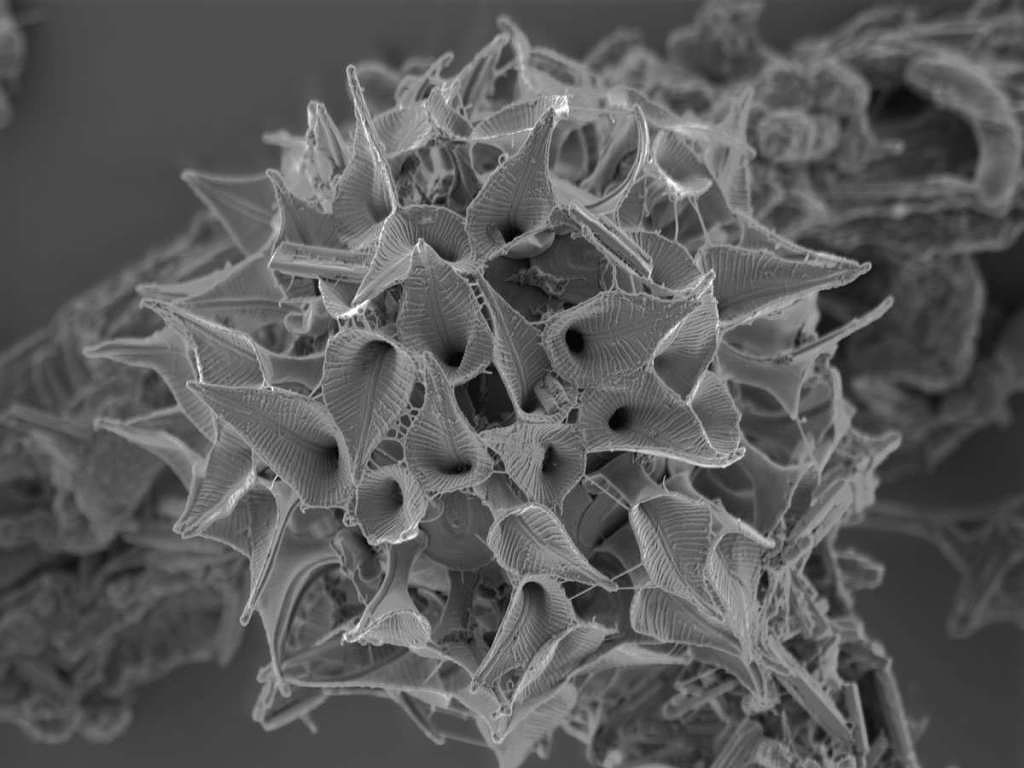
Pterocystis, a very small centrohelid surrounded by spathe-like siliceous scales. (Source: Eckhard Voelcker).
The website you and Steffen Clauß have created to house these images was named for Eugène Penard, and features a touching biography of the great amoebologist. Do you see your research as a revival or continuation of the kind of work he did? Obviously, alpha taxonomy is less ambitious, these days, and proceeds more slowly; but you have tools at your disposal that can open doors that were closed to pioneers like Leidy and Penard…
I think it would be greatly overstating our capabilities and ambitions to call it a revival or continuation of Penard’s work. But we hope that we can fill a niche. We do groundwork, trying to find amoebae hotspots, and scrutinize them for new species etc.
Next year will be a big change. I have retired from my normal job and Steffen will be working in his normal job only 50%, spending the other 50% in protistology with me. This gives us opportunities to become more professional and to isolate species for further investigation and also for sequencing. When you come home from a normal job, your kids demand attention, the cultures demand attention, there are images that need to be processed, species need to be identified … This has been difficult for us and often when we found something that would require more attention and care we would fail due to time restrictions. Our families have been very supportive and understanding but ultimately, there is only so much you can do when you have a normal job and a family. So now that we made all those changes, we have high hopes for the future.
What is the most challenging hurdle to getting into protists, in your opinion?
Getting into protists is easy, the challenge is coming later: finding a job in protistology that is paying!
Given your professional background in computers and software, do you have any thoughts on how IT could provide more support for protist research?
This is something that constantly amazes me. How can a group of such highly intelligent and educated people live with so little IT infrastructure support? Where is our species database? I want to be able to search based on traits. I want to see images. I want to see the latest papers on this subject. I want to know who has seen it, who is interested in it, etc., etc. I think that protist research would greatly benefit from a certain shared infrastructure. If they all would work for the same institution they would have an infrastructure like this in place within in a short period of time. It would make the entire group so much more efficient and the ROI would be quick and high.
Any other thoughts?
Spend less time surfing the internet and more time in front of your microscope. 😉
I will try to follow that advice! Thanks for taking the time to do this.
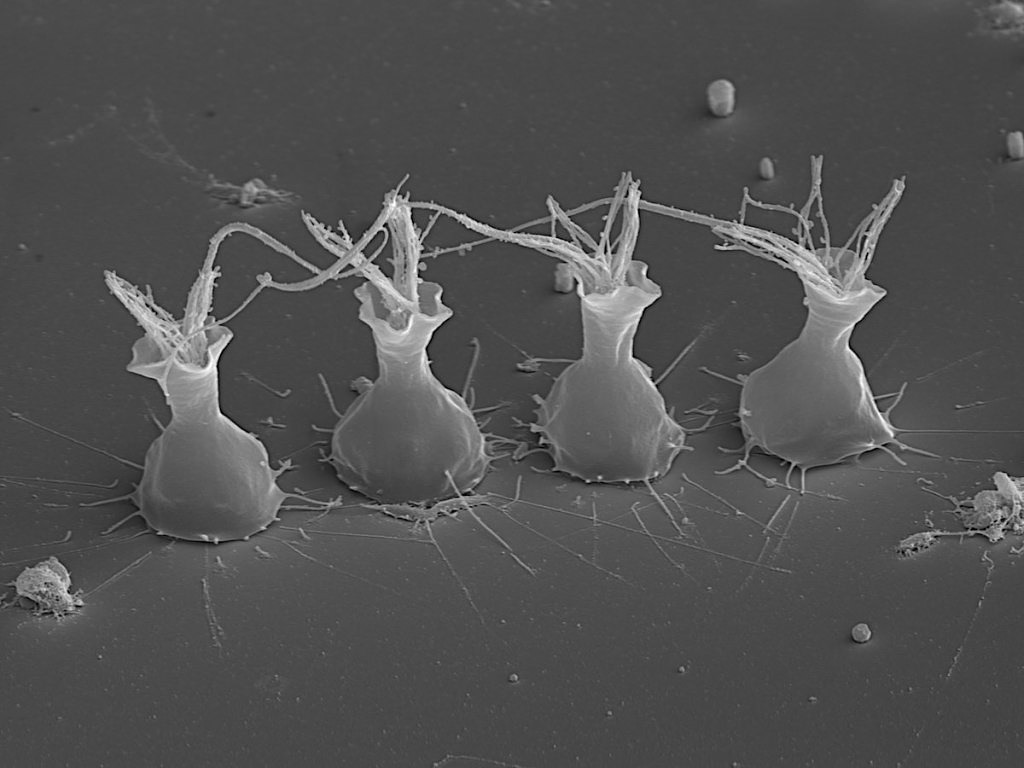
Some choanoflagellates (Choanomonada Kent 1880), members of the protist group most closely related to us. (Source: Eckhard Voelcker)

